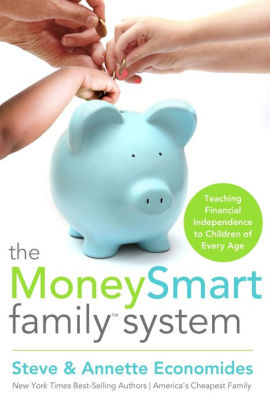“Money smarts” begin at home in this family-oriented guide to teaching wise management.
The Money Smart Family System by Steve and Annette Economides. Thomas Nelson, 2012, 253 pages

Reading Level: Teen, ages 15-18
Recommended for: ages 16-up
“America’s Cheapest Family” started out as a couple with a mutual conviction to live within their means—which at the time, was Steve’s moderate income as a graphic designer. Nine years and five kids later, they paid off their house and had the rudiments of a system for teaching their children to be successful money managers. How important is that? Consider the 5/50/500 rule:
- $5 is the average cost of each of your toddler’s whims from the age of 2-5. Giving in to these whims now will escalate to the
- $50 stage, where your 6-11 year-olds “need” pricey sneakers, designer jackets, and paintball parties, and if most of these desires are not checked, expect a
- $500 auto repair bill, lost smart phone replacement, or must-do junior class trip from your teenager, and don’t be surprised when he wracks up a
- $5000 credit-card bill at college. Convinced?
Steve and Annette Economides (what an apropos name!) don’t believe in a weekly allowance; instead they developed a point system with cash earned for regular chores, extra chores, and completing schoolwork. Also normal life skills like getting dressed on time and maintaining a good attitude. They include plenty of details as to how this works and how salary and responsibility increase over five age levels. What to do with the money they’ve earned? The two youngest age levels use a simple Give-Save-Spend system and are encouraged to work toward reachable goals with their savings. From age 9, the kids are responsible for buying their own clothes, with plenty of opportunity and training in finding bargains at resale shops. Teens are expected to save for gifts and special experiences like summer camp. Drivers pay for their own insurance, plus activities and fees, as well as savings for college. Every child opens a savings account as soon as he’s saved $25, and there’s a helpful exercise to show them how compound interest can add up.
Though the authors are Christians and emphasize the importance of giving both time and money, it’s not a specifically Christian book. There are no Bible verses or scriptural principles, beyond being responsible for what you have. I could have used this book fifty years ago.
Cautions: None
Overall rating: 4.5 (out of 5)
- Worldview/moral value: 4.5
- Artistic value: 5
For more practical and informative books on economics, see our “Talking about Money” post.
Stay Up to Date!
Get the information you need to make wise choices about books for your children and teens.
Our weekly newsletter includes our latest reviews, related links from around the web, a featured book list, book trivia, and more. We never sell your information. You may unsubscribe at any time.
Support our writers and help keep Redeemed Reader ad-free by joining the Redeemed Reader Fellowship.
Stay Up to Date!
Get the information you need to make wise choices about books for your children and teens.
Our weekly newsletter includes our latest reviews, related links from around the web, a featured book list, book trivia, and more. We never sell your information. You may unsubscribe at any time.
We'd love to hear from you!
Our comments are now limited to our members (both Silver and Golden Key). Members, you just need to log in with your normal log-in credentials!
Not a member yet? You can join the Silver Key ($2.99/month) for a free 2-week trial. Cancel at any time. Find out more about membership here.
